Last Updated: Jun 20, 2023
What is passing in soccer/football?
Passing the ball is a technique that must be mastered by any player in the world.
It is considered to be the most simple but powerful technique in the world of soccer.
However, there are several types of passes you should know and use to your advantage.
In this article, you are going to learn everything there is to know about passing the ball in soccer, and most importantly, you’ll unlock the secrets to dominating the pitch with passes.
Let’s get started.
Quick Navigation
- What Is Passing In Soccer?
- Why Is Passing Important?
- The Importance Of Timing And Accuracy In Passing
- How to Pass a Ball in Soccer?
- Different Types Of Passing In Soccer
- 1-What Is A Key Pass In Soccer?
- 2. Square Pass In Soccer
- 3. What Is A Push Pass In Soccer?
- 4. Through Pass
- 5. Reverse Pass
- 6. What Is A Back Pass In Soccer?
- 7. Wall Pass Combination
- 8. Cross Pass
- 9. Lob Pass
- 10. Long Pass
- 11. One-Touch Pass
- 12. Diagonal Pass
- 13. Chipped Through Pass
- 14. Grounded Through Pass
- 15. Switch Pass
- 16. Overlapping Pass
- 17. Dummy Pass
- Difference Between Wall Pass and Push Pass
- Final Thoughts
What Is Passing In Soccer?
Passing in soccer refers to the fundamental technique of transferring the ball from one player to another using various body parts. It is a crucial skill that enables team collaboration, ball control, and the creation of scoring opportunities by maintaining possession and manoeuvring strategically on the field.
Why Is Passing Important?
Passing is important in soccer because it is the best way to build up play and create tactics and strategies to score goals.
Remember, every game is played with 11 players from each team. So, you can’t just take the ball and run to score yourself.
Although some players have shown some capacity to dribble several players and score, the probability to do that in modern soccer is low.
Also, if you try to hold the ball for too long and not pass it to your teammates, you could lose it. If you lose it, the opposition could get it and score. On top of that, your coach and teammates will blame you and you could potentially be benched for the next games.
This is why it’s important to pass the ball to your teammates unless you have an opportunity to shoot on target.
The Importance Of Timing And Accuracy In Passing
Timing and accuracy are crucial when it comes to passing in soccer. A well-timed pass can create a clear opportunity for a goal, while a poorly-timed pass can result in the loss of possession and an opportunity for the opposing team to score.
Timing is also important when it comes to playing the ball through the defense to a teammate who is making a run, as the pass must be made at the right moment for the teammate to be onside and able to receive it.
Accuracy is also crucial in passing, as an inaccurate pass can result in the ball going out of bounds, being intercepted by the opposing team, or not reaching its intended target.
An accurate pass, on the other hand, can maintain possession of the ball, create scoring opportunities, and put pressure on the opposing team.
To improve accuracy, you must practice and master the proper techniques for passing, such as striking the ball with the middle of the inside of the foot and following through towards the target.
How to Pass a Ball in Soccer?
Here’s a step-by-step guide on how to pass a ball in soccer:
- Position yourself: Get into a suitable position to receive the ball and have a clear view of your teammates.
- Focus on your target: Lock your eyes on the intended recipient of your pass to ensure accuracy and precision.
- Use the inside of your foot: Strike the ball with the inside of your foot, near the middle, for better control and accuracy.
- Follow through: Extend your kicking leg and follow through towards your target to add power and direction to the pass.
- Consider timing: Choose the right moment to release the pass, accounting for the movements of your teammates and the positioning of opponents.
- Pass with purpose: Aim to pass the ball with intention, either to maintain possession or create scoring opportunities for your team.
- Practice regularly: Improve your passing technique through consistent practice sessions, focusing on accuracy, timing, and different passing scenarios.
- Understand the game: Develop a strong understanding of the game, including the positioning of players, to make effective decisions while passing.
Remember, passing skills can be honed over time, so keep practising and learning from each experience to enhance your ability to pass the ball effectively in soccer.
Different Types Of Passing In Soccer
Here are the 17 types of passing in soccer:
1-What Is A Key Pass In Soccer?
A key pass in soccer refers to a pass that has the potential to directly lead to a goal-scoring opportunity for the receiving player. It is a decisive and impactful pass that breaks through the opponent’s defense, creating a clear chance for the attacking team.
Not necessarily an assist, but a pass that can break the entire opponent block and allow the players in the front to create a big chance to score.
Typically executed by midfielders, a key pass requires vision, accuracy, and an understanding of the movements of teammates and opponents.
It is a significant contribution to the attacking play, contributing to the overall strategy of unlocking the opposition’s defense and creating goal-scoring opportunities.
2. Square Pass In Soccer
A square pass is a training drill that allows players to get used to a passing pattern. This training drill consists of having four players standing on each cone and executing short passing around the square. Each player should pass the ball and follow their pass.
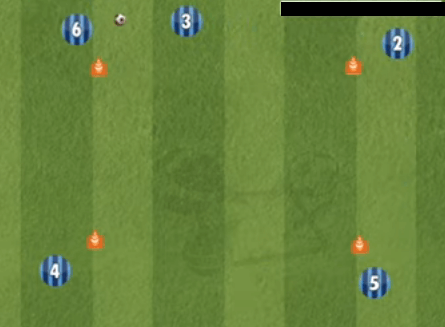
3. What Is A Push Pass In Soccer?
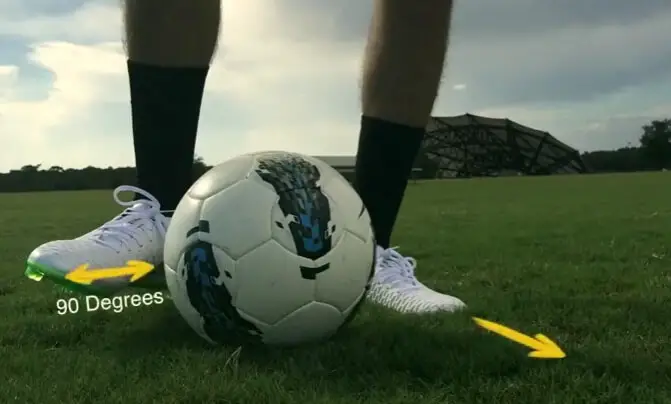
The push pass consists of passing the ball to your teammate. It is without a doubt the most used technique in soccer. Although it might seem very simple, it takes a lot of training to perform this skill with accuracy throughout the game.
A proper technique is crucial for the accuracy and success of your passes.
Strike the ball with the middle of the inside of the foot and follow through towards your target.
A lot of problems occur when you pass the ball outside of this area.
But if you want to get the most power and accuracy, you need to make contact with the ball at the base of your foot.
Plus, your hips should face your intended target.
4. Through Pass
A pass through the opponent’s defence intended for a teammate to run into space and beat the offside trap is called a “Through Pass” in soccer.
Here are some key points to keep in mind:
- Make sure your teammate is not offside when you’re playing the ball
- Time your pass perfectly for the run of your teammate.
- You can pass the ball on the ground, chip it, swing it or bounce it.
- Try to place the ball right inside of the defensive line and put it in the running line of your teammate.
5. Reverse Pass
A reverse pass relies a lot on deception with different body parts to unlock the tight spaces behind the defence. During a soccer game, passing the ball to a teammate while facing another direction is called a reverse pass.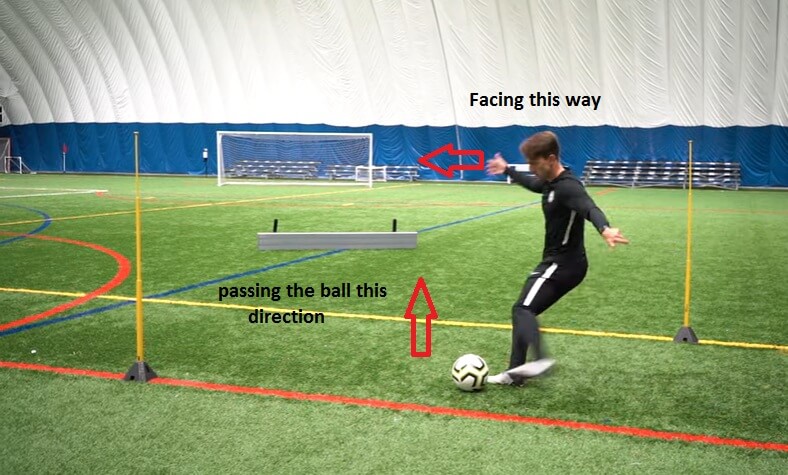
Here are some key points to keep in mind while executing a reverse pass:
- To execute a reverse pass, make sure to keep your hips going one way, then pass the ball another way.
- Make sure to have good space for balance and to kick out the ball. Work on your support foot.
- Focus on where your eyes are looking. Don’t indicate where you are about to pass the ball. So, face the same direction as your hips.
6. What Is A Back Pass In Soccer?
In soccer, a back pass occurs when a defender intentionally passes the ball back to the goalkeeper. This strategic move is often observed when a team is in possession and aims to maintain control while managing the game’s tempo.
By passing the ball back to the goalkeeper, defenders create a safe outlet for recycling possession and resetting the play.
This allows the team to regroup, assess their options, and build a new attacking sequence with a composed approach.
The back pass enables the team to control the pace of the game, frustrate opponents’ pressing efforts, and minimize the risk of losing possession in dangerous areas.
It also offers an opportunity for the goalkeeper to participate in the team’s passing game and showcase their ball-handling skills.
While it may result in a more conservative style of play, the back pass serves as a valuable tactical tool in soccer to maintain possession, dictate play, and ultimately increase the team’s chances of success.
Why do soccer players pass backwards?
Soccer players pass backwards for two main reasons:
- To waste a few seconds. This happens when the leading team knows the game is almost over.
- When the opponent team is too compact. This is usually the best situation to back-pass the ball to open the opposing block.
Keep in mind that when receiving the ball, the goalkeeper is not allowed to pick it up with his hands, otherwise, a penalty is going to be given to the opponent team. Hence goalkeepers must learn to play with their feet.
Manuel Neuer is the perfect example with some technical abilities.
7. Wall Pass Combination
A wall pass, also known as a 1-2 or give-and-go, is a clever passing combination between two players. It involves one player passing the ball to a teammate and quickly moving into open space to receive a return pass, effectively bypassing an opponent.
Let’s say you are walking towards the opponent’s goal and a defender is trying to stop you. Instead of trying to dribble, you can simply pass the ball to your teammate and move around the defender as soon as possible. Your teammate is finally giving you the ball back without controlling it and you can finish.
Note that your teammate should give you back the ball in front of you and not behind.
How to practice a wall pass in soccer?
Practising a wall pass is very simple. Take two of your friends, one should be the defender and the other your teammate.
Then practice as mentioned earlier.
Some key points to remember when practising:
- Run behind the defender.
- Your teammate should play the ball into space.
8. Cross Pass
A cross pass in soccer is a skilful technique where a player passes the ball from the wider areas of the field towards the central area near the opponent’s goal.
This type of pass is often used to create scoring opportunities for teammates by delivering the ball into a dangerous area where attacking players can make runs and attempt to score.
The cross pass requires precision and accuracy to ensure that the ball reaches the intended target in a position favourable for a goal-scoring chance.
9. Lob Pass
In soccer, a lob pass, also known as a chip pass, is a clever and tactical way to move the ball over opponents or a defensive line.
Instead of playing the ball along the ground, the lob pass involves lifting the ball with finesse and precision to bypass defenders and create opportunities for teammates.
This pass is particularly effective when there is limited space or when the goalkeeper is off the goal line, allowing the receiving player to control the ball in a scoring position.
10. Long Pass
The long pass is a powerful technique used to cover a greater distance on the field. It involves striking the ball with force and accuracy to send it over a longer distance, often from deep areas of the field to players in advanced positions.
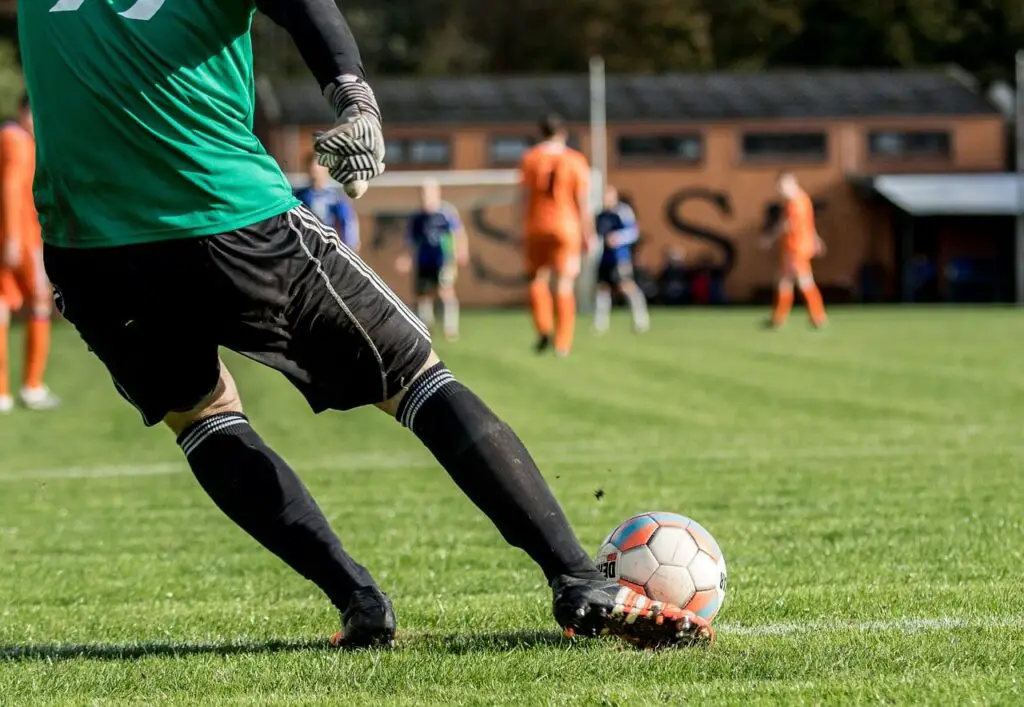
The purpose of a long pass is to quickly switch play, bypass opponents, or initiate an attacking move from a defensive position.
Executing a successful long pass requires good vision, technique, and timing to ensure that the ball reaches the intended target.
11. One-Touch Pass
The one-touch pass is a swift and efficient way to maintain possession and keep the flow of play moving. It involves receiving the ball and immediately passing it to a teammate with a single touch, without taking additional touches to control it.
The one-touch pass requires excellent anticipation, awareness, and quick decision-making to assess the positioning of teammates and opponents and execute a precise pass.
This pass is often used in fast-paced situations to keep the opposition off balance and create opportunities for attacking plays.
==>> You can also read the meaning of a First Touch in soccer here.
12. Diagonal Pass
A diagonal pass in soccer involves playing the ball diagonally across the field, from one side to the other. This pass is commonly used to exploit spaces and create new passing angles by bypassing opposition players.
By changing the direction of play with a diagonal pass, teams can quickly shift the focus of the attack and catch opponents off guard.
The diagonal pass requires accuracy and weight on the pass to ensure that the ball reaches the intended teammate, who can then continue the attack or switch play to a different area of the field.
You can check out Let’s go coach to read more about the diagonal passes.
13. Chipped Through Pass
A chipped-through pass combines elements of a chip pass and a through pass to create a unique and effective attacking move.
With this pass, the ball is lofted over the defensive line into open space for a teammate to make a well-timed run and receive the ball in a scoring position.
The chipped-through pass requires precise execution to clear the defenders and place the ball at the perfect height and distance for the teammate to reach it.
This pass can be a valuable weapon in breaking down a compact defense and creating goal-scoring opportunities.
14. Grounded Through Pass
The grounded through pass is a low and driven pass along the ground that is played into space behind the defensive line for a teammate to run onto. It is often used to exploit gaps in the defense and create goal-scoring chances.
The grounded through pass requires good timing, accuracy, and vision to identify the right moment to release the pass and the right angle to deliver it into space.
This pass allows the receiving player to make a quick run onto the ball, maintaining control and creating a direct path towards the opponent’s goal.
15. Switch Pass
A switch pass, also known as a cross-field pass, is a strategic manoeuvre that involves quickly changing the direction of play from one side of the field to the other.
By switching the ball from one flank to the opposite flank, teams can stretch the opposition’s defense, create more space, and find new attacking opportunities.
The switch pass requires precise and powerful execution to cover a long distance with accuracy. It demands good awareness of teammates’ positions and effective communication to orchestrate the movement of the ball across the field.
16. Overlapping Pass
An overlapping pass is a collaborative play between two players where one player runs beyond their teammate who has possession of the ball. The player in possession then plays a pass into space for the overlapping teammate to continue the attack down the flank.
The overlapping pass is a way to exploit the gaps left by defenders and create dangerous crossing opportunities.
It requires good timing, coordination, and understanding between the two players involved to execute the pass and receive it in stride while maintaining the attacking momentum.
17. Dummy Pass
A dummy pass is a deceptive move in which a player lets the ball pass through their legs without making contact, fooling opponents and creating confusion in the defense.
By pretending to play the ball, the player can trick opponents into committing to defend against a non-existent pass, opening up space for teammates to exploit.
The dummy pass requires excellent timing, coordination, and communication with teammates to ensure they are aware of the intended deception and ready to take advantage of the created space.
Difference Between Wall Pass and Push Pass
A wall pass involves a quick exchange between two players, creating a dynamic attacking move. It bypasses defenders. A push pass is a fundamental technique using the inside of the foot to accurately distribute the ball.
Wall pass emphasizes combination play, while push pass focuses on accurate distribution.
Final Thoughts
As you learned from this article, there are different types of passing in soccer/football. But you don’t have to master all of them. All you need is the ability to pass the ball with accuracy to a teammate by using the inside of your foot.
What did you learn new from this article? Do you know any other type of passing? Let us know in the comment section below.

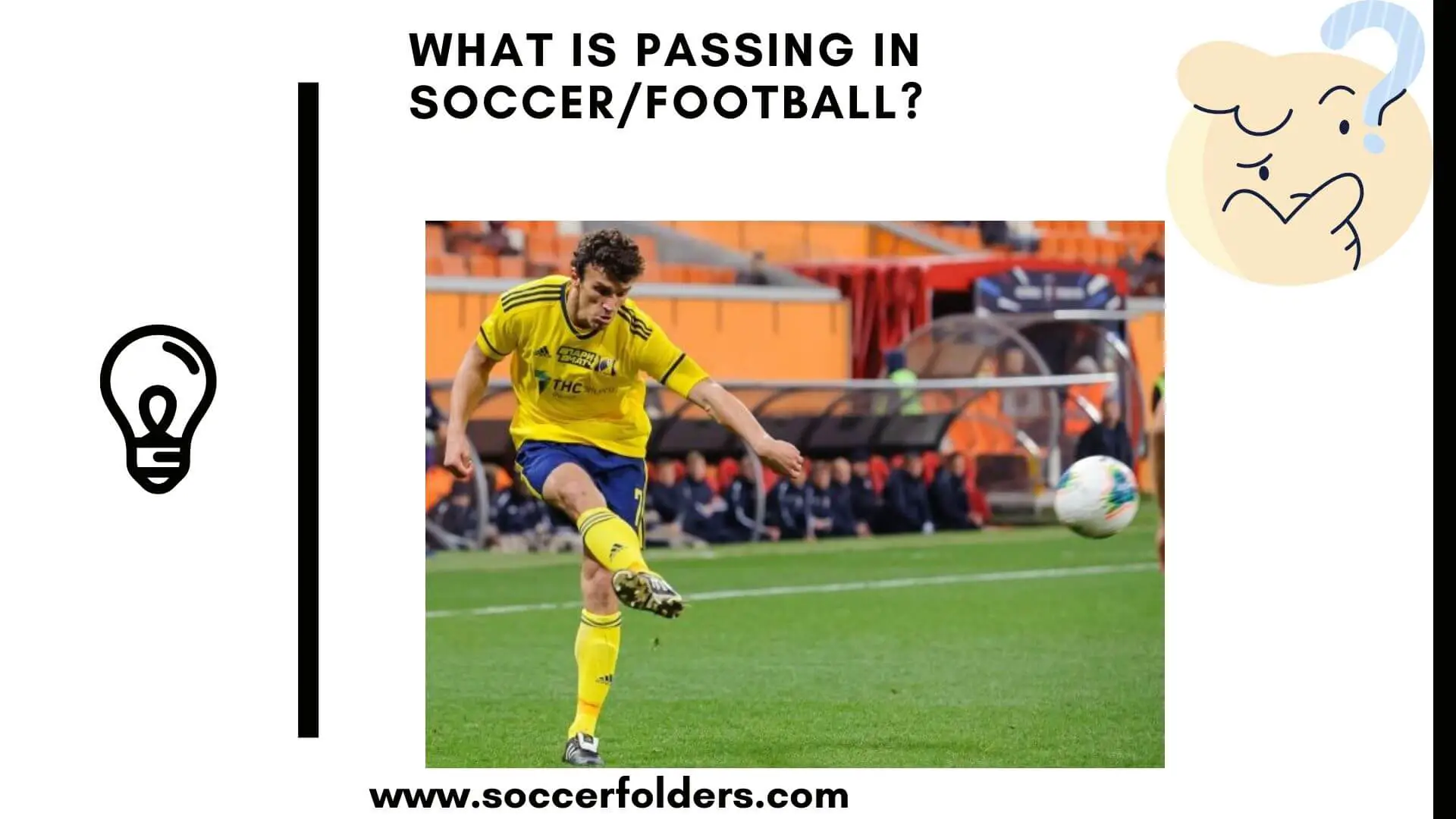
During the pandemic, I have focused on increasing my accuracy passing the ball. I have set a target and trained daily. When social distancing was made flexible and we return to having games I have noted that my passing stats have improved. But I know I can keep getting better. So, I have been researching more technical aspects. And your post has helped me with them. Thank you very much!
Hi, Paolo. I am glad the article was helpful. Also, congrats on the improvement of your passing ability. Hard work has always paid off. Keep up training